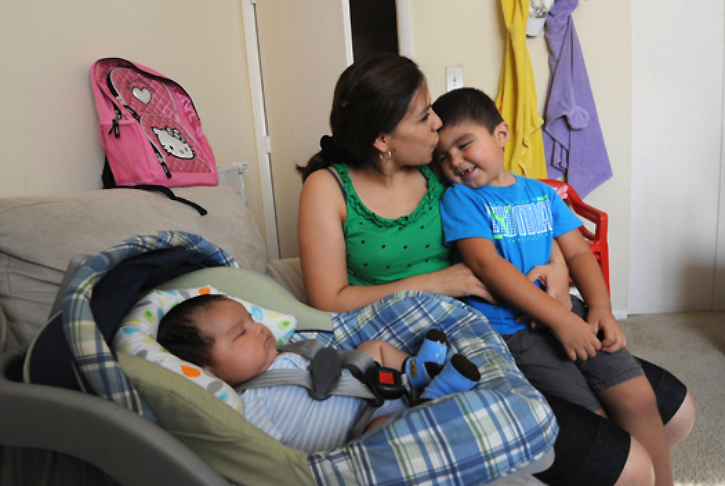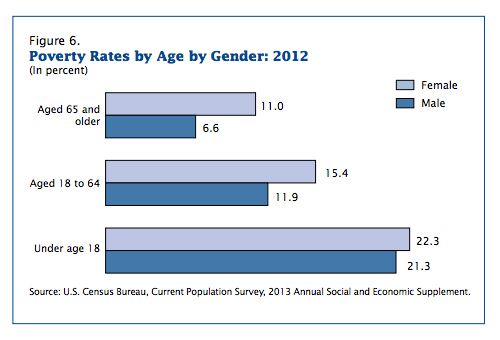
April Saul/Philadelphia Inquirer/MCT
At their Warminster, Pennsylvania, home, Imelda Rodriguez and two of her three children: Danny, 3; and David, 2 months. She said she waits as long as she can to change diapers. For low-income parents like Rodriguez, a 34-year-old married homemaker in Warminster, Pa., it’s sometimes easier to get food than diapers, which can cost as much as $100 a month for one child.
WASHINGTON — More than 16 million American children, or nearly 22 percent, lived in poverty in 2012, the U.S. Census Bureau reported Tuesday.
Advocates for the poor expressed alarm over the proportion of children in poverty, which remained statistically unchanged since 2011.
“[Children] are still the age group suffering the most poverty, and there are more than 7.1 million children living in extreme poverty – below $9,142 for a three-person family,” said Deborah Weinstein, executive director of the Washington-based Coalition on Human Needs.
The new Census figures also show the percentage of families living in poverty, 11.8 percent, or about 9.5 million, remained stable from 2011 to 2012. But among families with a female head of household, a much higher proportion, about 31 percent, lived in poverty in 2012, the Census Bureau said.
The poverty threshold in 2012 was $23,492 for a family of four.
Overall poverty and income statistics changed little from 2011 to 2012, with neither median household income falling significantly nor poverty rising, the Census figures show.
“The poverty and income numbers are a metaphor for the entire economy,” said Brookings Institution Senior Fellow Ron Haskins. “Everything’s on hold, but at a bad level: Poverty and income did not change much in 2012.
“So child poverty is still too high and family income is still too low,” added Haskins, the co-director of the Brookings Center on Children and Families. “The recession may be over, but try telling that to these struggling families.”
Haskins said the situation’s unlikely to change much until the U.S. economy begins to generate more jobs.
For the nation as a whole, the poverty rate stood at 15 percent, or 46.5 million people, living at or below the poverty line, statistically unchanged from 2011.
The childhood poverty rate is particularly troubling, given what it portends for children’s futures, Brookings Senior Fellow Isabel V. Sawhill said.
Of those who spent more than half their childhoods in poverty, 45 percent were poor at age 35, compared with 0.6 percent of those who spent none of their childhoods in poverty, Sawhill said.
“Poverty in early childhood is a particularly mobility-crushing experience because the lack of resources and stresses of poverty limit development,” she said.
“In short, reducing the number of children growing up in poverty is strongly related to the broader goal of social mobility. Poverty may be politically and rhetorically unpopular, but it must remain firmly in the policy conversation if we are serious about opportunity and social mobility.”
The Census Bureau’s official measure of poverty doesn’t include Supplemental Nutrition Assistance Program benefits.
The Bureau, however, said that when measuring SNAP benefits as part of income, the program formerly known as food stamps lifted 4 million Americans above the poverty line in 2012.
“SNAP is highly effective in reducing the extent and depth of poverty and reducing hunger, but millions of Americans still struggle to afford food,” Sharon Parrott, vice president for budget policy and economic opportunity at the Center on Budget and Policy Priorities, wrote in a blog post.
The release of the new Census data came as House Republicans prepare to vote on a bill that would slash $40 billion over 10 years from SNAP, a move advocates say would be devastating to those most in need.
On a positive note, the Census figures showed the proportion of uninsured children fell from 9.4 percent in 2011 to 8.9 percent in 2012.
Overall, the number of people with health insurance increased from 260.2 million, or 84.3 percent, in 2011 to 263.2 million, or 84.6 percent, in 2012.
The proportion of Americans covered by private health insurance remained steady, at about 63.9 percent, while the percentage covered by government health insurance rose from 32.2 percent to 32.6 percent.
First Focus Campaign for Children, a bipartisan children’s advocacy group, said the latest Census figures underscore the need for federal government investments in children’s health insurance and nutrition.
Specifically, First Focus pointed to SNAP, Medicaid, the Children’s Health Insurance Program (CHIP) and family tax credits.
“The good news is we know what works to lift children out of poverty, and our leaders in Congress have opportunities to protect these investments in the upcoming budget debates,” First Focus spokesman Ed Walz said in a news release.































